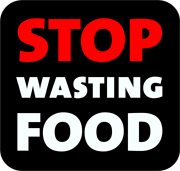Today’s post will also appear on GOOD’s new food site. As part of their Food For Thinkers series, the site has asked a bunch of food writers (I’m honored to be one) to wrestle with this question:
What does—or could, or even should—it mean to write about food today?
An intriguing question, for sure. And so…
For many of us, writing about food today means considering the environmental impact of our food choices. Knowing what we now know about monocultures, factory farms, petrochemical fertilizers, pesticide runoff and transcontinental shipping, it’s hard to write about anything but the sustainability of what we eat. To extol local and organic, hopefully not at the expense of enjoying our food.
 I believe food writers can celebrate the joy that food brings while raising the right food flags. As I see it, my role in the sustainability cause is spotlighting one of its seldom considered facets: food waste.
I believe food writers can celebrate the joy that food brings while raising the right food flags. As I see it, my role in the sustainability cause is spotlighting one of its seldom considered facets: food waste.
And I think it’s a vital part of the discussion. Waste undermines sustainability to an extent. If you buy a locally-raised, organic-fed whole chicken, and it sits in your freezer for a year before being tossed, those adjectives matter less. On the macro level–what’s less sustainable than growing about twice the amount of needed calories and then discarding about half of them?
As I see it, waste is one of the largest threats to our food supply. I’m not alone there, as the recent State of the World 2011 report warned about waste. As hunger persists, reducing waste and improving (re)distribution are vital. And as the global population inches toward 7 billion, we need to be more efficient with what we grow to ensure that all are fed.
Food waste also has a significant environmental impact. Agriculture is a real resource hog. A massive amount of oil goes into growing, harvesting, processing, shipping and cooling our food. At least 2% of all U.S. energy consumption goes to produce food that is thrown away. And agriculture represents about 80 percent of all water consumption.
To invest all of those resources in producing food that we then freely waste is a real shame. Yet, waste we do. We squander about 40 percent of our food. Our wasting is on the rise, as it has increased 50 percent since 1974.
And that waste has a double impact. In addition the aforementioned squandered resources, food that rots in a landfill emits methane, a greenhouse gas more than 20 times as potent at trapping heat. We’re aiding climate change through our trash cans.
I believe that food should be treasured. Certain items a bit more so than others (deep-fried Twinkies come to mind). At the very least, we should value our edibles. Because all foods serve a purpose, whether it’s to nourish, delight or unite. Whether you grow, cook, eat, or write about food (maybe all of the above), minimizing our food waste is the ultimate way to honor it.
 I believe food writers can celebrate the joy that food brings while raising the right food flags. As I see it, my role in the sustainability cause is spotlighting one of its seldom considered facets: food waste.
I believe food writers can celebrate the joy that food brings while raising the right food flags. As I see it, my role in the sustainability cause is spotlighting one of its seldom considered facets: food waste.

 The non-profit aims to reduce the amount of food wasted in Denmark through a variety of means. There’s the site, which does plenty to raise awareness (and I’m sure does plenty more if you understand Danish). There’s a forthcoming cookbook on how to use up leftovers, in which top Danish chefs, politicians and food personalities lend their expertise.
The non-profit aims to reduce the amount of food wasted in Denmark through a variety of means. There’s the site, which does plenty to raise awareness (and I’m sure does plenty more if you understand Danish). There’s a forthcoming cookbook on how to use up leftovers, in which top Danish chefs, politicians and food personalities lend their expertise.